
| Essay type: | Proposal essays |
| Categories: | Knowledge Chemistry |
| Pages: | 3 |
| Wordcount: | 731 words |
Fluidized catalytic cracking processes is one of the essential chemical engineering and industrial activity, which is specifically distinct for petroleum refinery conversion processes (Rodger, 2000). This project is mainly for improving the catalytic process’ accuracy and speed by introducing the most recent technology- the use of a modernized biochemical catalyst that is non-pollutive. This industrial practice transforms heavier functional fractions of hydrocarbon into petroleum vapor via the aid of a catalyst, which is ideal in controlling the process mainly by fastening the pace of conversion. Besides, this research internalizes how the new catalysts and modern technology in the catalytic fluidized bed converters would significantly impact reactions’ activation energy faster as compared to other catalysts mainly common in oil refineries (Changsong Hu, 2017).
Significance of the Project
As opposed to most of the ancient cracking processes, which are comparatively expensive and susceptible to inevitable system uncertainties like a power outage, this modernized fluidized bed catalytic cracking is pocket friendly and simple to install, operate, and manage (Fang Wang, 2018). Furthermore, due to the use of most recent biochemical technological advancements in it, it results in a significantly higher yield of branched hydrocarbons that are more chemically unsaturated and structurally aromatic (Jarullah et al., 2017). This industrial cracking technique is utterly accurate as it is effectively controlled and managed than the famously known liquid phase thermal cracking and vapor-phase thermal cracking, among others, respectively (Benard, 2011). For instance, a catalytic transformation of oil into its constituent gasoline products in the presence of Al2O3 at a standard temperature varying from 273K to 673K at a pressure of 3atm, via the aid of Equivalent Reactor Network (ERN) is explicitly accurate, reliable, and precise in getting pure final products (Weimer 1997).
Aims of the Project
This modernized catalytic cracking results in petroleum products with significantly negligible percentage concentration of elemental pollutants like sulfur. Collectively, the consequential products of this process are relatively purer with reliably better anti-knocking functional properties (Zhao, 2014). Besides, the final petroleum products of this process have a relatively higher-octane number, which is the most profoundly common and universal expectation of every refinery industrial setting, unlike straight-run petrol retrieved from thermal and other ancient and commonly used industrial decomposition-linked cracking.
Plan of Action and Methodology
The most appropriate methodological modeling approach for this project is completely dependent on simplified fluidized bed reactors connected to short effective computational hardware and software for ultimately higher accuracy and time considerations (Gladys Jimenez, 2011). The project proposes the usage of Equivalent Reactor Network (ERN) and modernized decomposition catalyst, which enhances dynamic simulation of readings, product quality optimality, and general control of the whole fluidized bed catalytic cracking model, respectively.
Bibliography
Benard, M. J.-L. &. S., 2011. Process for the catalytic cracking of hydrocarbons in a fluidized bed and their applications. US Patent, 4(8), pp. 583-883. Available at: https://patents.google.com/patent/US4883583A/en
Changsong Hu, R. X. &. H. Z., 2017. Ex-situ Catalytic Fast Pyrolysis of Biomass Over HZSM-5 In a Two-stage Fluidized Bed /Fixed-bed Combination Reactor. Bioresource Technology, Volume 243, pp. 1133-1140. Available at: https://www.sciencedirect.com/science/article/pii/S0960852417310970
Fang Wang, X. Z. Y. &. S. T., 2018. Characteristics of Tar Abatement by Thermal Cracking and Char Catalytic Reforming in a Fluidized Bed Two-Stage Reactor. Fuel 231, pp. 18-25. Available at: https://www.sciencedirect.com/science/article/pii/S0016236118308664
Gladys Jimenez, R. A. &. R. M.-Y., 2011. The Fluidized-Bed Catalytic Cracking Unit Building: It's Future Environment. Fuel, 90(12), pp. 3530-3541. Available at: https://www.sciencedirect.com/science/article/pii/S0016236111001852
Jarullah, A. T., Awad, N. A., & Mujtaba, I. M. 2017. Optimal Design and Operation of an Industrial Fluidized Catalytic Cracking Reactor. Fuel, 206, 657-674. Available at: https://bradscholars.brad.ac.uk/bitstream/handle/10454/12183/Mujtaba_Fuel.pdf?sequence=4&isAllowed=y
Khongprom, P., Ratchasombat, S., Wanchan, W., Bumphenkiattikul, P., & Limtrakul, S. 2020. Scaling of a Catalytic Cracking Fluidized Bed Downer Reactor based on Computational Fluid Dynamics Simulations. RSC Advances, 10(5), 2897-2914. Available at: https://pubs.rsc.org/en/content/articlehtml/2020/ra/c9ra10080f
Rodger, T. J. C. &. L., 2000. Sequential Catalytic and Thermal Cracking for Enhanced Ethylene Yield. US Patent, 6(33), p. 555.Available at: https://patents.google.com/patent/US6033555A/en
Weimer, W. A., 1997. Fluidized Bed Reactor Processes.
Zhao, Y. P. D. &. H., 2014. An Integrated Methodology for the Modelling of Fluid Catalytic Cracking Riser Reactor. Applied Petrochemical Research, 4(4), pp. 420. Available at: https://link.springer.com/article/10.1007/s13203-014-0084-8
Cite this page
Paper Example - Fluidized Catalytic Cracking. (2023, Nov 15). Retrieved from https://speedypaper.com/essays/fluidized-catalytic-cracking
Request Removal
If you are the original author of this essay and no longer wish to have it published on the SpeedyPaper website, please click below to request its removal:
- Free Essay with Chemistry Problem Solving
- Free Essay with an Engineering Personal Statement
- Education Essay Sample: Early Intervention for Learners with Emotional or Behavioral Disorders
- What Will My Footprint Mean to the World? Scholarship Essay Example
- Free Essay Example - Review on Education in Texas
- Proper Tagging and Labelling Evidence - Free Essay
- Paper Example on Receptor Activity: Key Role in Living Organisms
Popular categories




